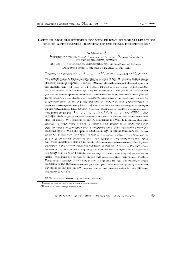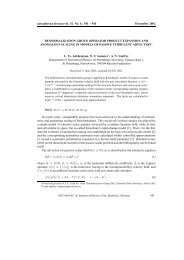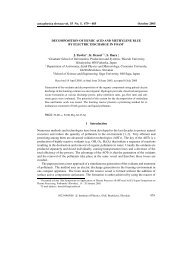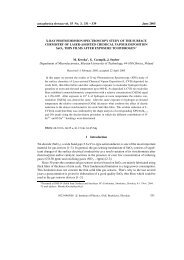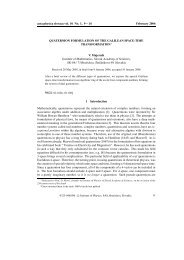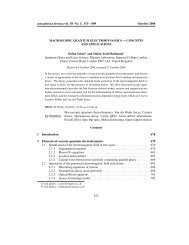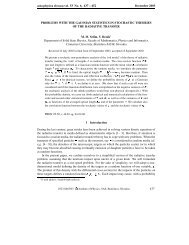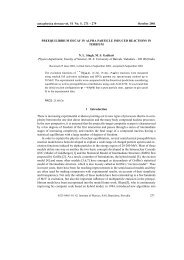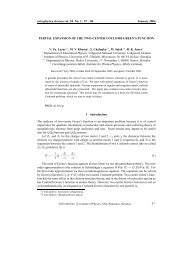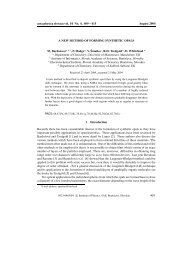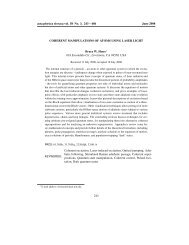Two-pulse spin echo in two-level systems inside ... - physics.sk
Two-pulse spin echo in two-level systems inside ... - physics.sk
Two-pulse spin echo in two-level systems inside ... - physics.sk
You also want an ePaper? Increase the reach of your titles
YUMPU automatically turns print PDFs into web optimized ePapers that Google loves.
68 L. L. Chotorlishvili et al.<br />
α 1 = cos [Ω 1 (∆ω)t 1 /2] + i cos [θ 1 (∆ω)] s<strong>in</strong> [Ω 1 (∆ω)t 1 /2] ,<br />
β 1 = s<strong>in</strong> [θ 1 (∆ω)] s<strong>in</strong> [Ω 1 (∆ω)t 1 /2] ,<br />
β 2 = s<strong>in</strong> [θ 2 (∆ω)] s<strong>in</strong> [Ω 2 (∆ω)t 2 /2] ,<br />
[<br />
Ω 1,2 (∆ω) = γnη 2 2 (∆ω)(h (1,2) ) 2 + ∆ω 2] 1/2<br />
,<br />
tn[θ 1,2 (∆ω)] = γ n h (1,2) η(∆ω)/∆ω .<br />
Here h (1,2) is the radio-frequency field amplitude, t 1 and t 2 denote the duration of radiofrequency<br />
field.<br />
When we have wide angles of rotation (Ω 1,2 t 1,2 >> 2π) for the same radio-frequency<br />
<strong>pulse</strong>s, the <strong>in</strong>tegration by ∆ω removes fast oscillat<strong>in</strong>g factors s<strong>in</strong> Ωt and cos Ωt down to zero.<br />
Therefore, the formula (1) takes the simplest form:<br />
|∆M(ω, t)| = 3m δω/2<br />
∫<br />
0<br />
16 ∣ d(∆ω)(ω nd − ω nw ) −1/2 (∆ω d − ∆ω) −1 (∆ω − ∆ω w ) −1/2 ·<br />
−δω/2<br />
(2)<br />
· ∆ωη 4 (∆ω)(γ n h) 3[ ∆ω 2 + (γ n η(∆ω)h) 2] 2 exp [−i∆ω(t − 2τ12 )]<br />
∣ .<br />
The peculiarity of TLS is the dispersion of splitt<strong>in</strong>g energy E requir<strong>in</strong>g the obta<strong>in</strong>ed expression<br />
to be averaged by distribution function. The further simplification of (2) also depends on<br />
E. When E/¯h ∼ ω n where ω n is the carrier frequency of the receiver, δω >> γ n hη(∆ω) is<br />
valid δω is the TLS l<strong>in</strong>e shape width caused by Klauder-Anderson mechanism [17], equals to the<br />
passband width of the receiver). In this case the expression<br />
∆ω exp [−i∆ω(t − 2τ 1,2 )] ÷ [ ∆ω 2 + (γ n hη(∆ω)) 2] 2<br />
is the fast-oscillat<strong>in</strong>g factor under the <strong>in</strong>tegral (2). Therefore, for ∆ω = 0 other factors can<br />
be removed from under the sign of the <strong>in</strong>tegral and thereafter the limits of <strong>in</strong>tegration tend to<br />
<strong>in</strong>f<strong>in</strong>ity. As a result, tak<strong>in</strong>g <strong>in</strong>to account the averag<strong>in</strong>g by the TLS distribution function, we have<br />
¯p<br />
E∫<br />
max<br />
∫ E<br />
E=0 ∆ 0=0<br />
EdEd∆ 0<br />
∆ 0<br />
√<br />
E2 − ∆ 2 0<br />
,<br />
here ¯p is the TLS state density and ∆ 0 is the TLS tunnel<strong>in</strong>g parameter. For the resonant TLS, the<br />
energy of which is with<strong>in</strong> the <strong>in</strong>terval ¯hω n − ¯hδω < E < ¯hω n + ¯hδω, we have<br />
|M(ω, t)| ∼ ¯p<br />
¯hω n+¯hδω ∫<br />
∫ E<br />
¯hω n−¯hδω ∆ 0=0<br />
√ ∣∣∣∣<br />
E/¯h − ω n<br />
E/¯h − ω<br />
∣ |t − 2τ 12| exp<br />
[− (|E/¯h − ω n|) 1/2 ]<br />
EdEd∆ 0<br />
√<br />
|t − 2τ 12 | ∆ 0 E2 − ∆ 2 0<br />
(3)



